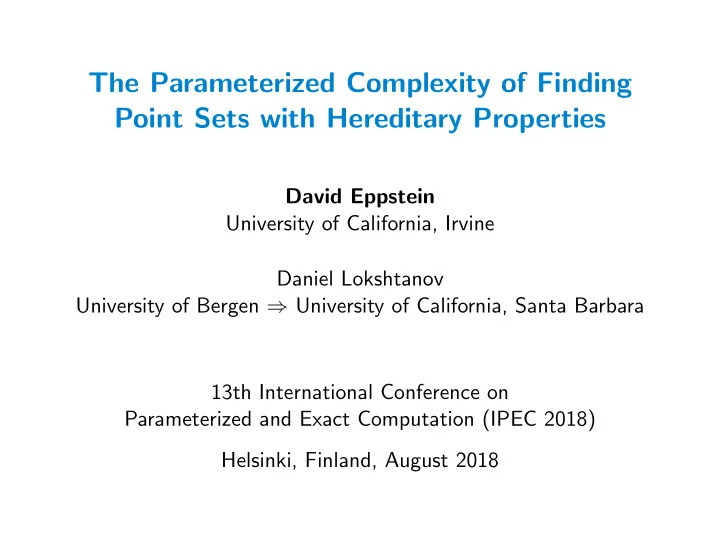

The Parameterized Complexity of Finding Point Sets with Hereditary Properties David Eppstein University of California, Irvine Daniel Lokshtanov University of Bergen ⇒ University of California, Santa Barbara 13th International Conference on Parameterized and Exact Computation (IPEC 2018) Helsinki, Finland, August 2018
A puzzle from Dudeney (1917) Later known as the “no three-in-line puzzle” Every n × n grid has Ω( n ) points with no three in line (Erd˝ os) but it’s unknown whether 2 n is always achievable
Dudeney’s puzzle as a parameterized problem Given a finite set of points in the Euclidean plane (the 64 points of an 8 × 8 grid Find a subset of k points in general position (no three collinear; in Dudeney’s puzzle, k = 16) NP-hard and APX-hard but fixed-parameter tractable (Eppstein 2018, Theorems 9.3 and 9.5) 3 1 2 2 4 3 1 5 4 5 Hardness reduction from maximum independent set Blows up the parameter so does not show parameterized hardness
The happy ending theorem Every five points in general position include the vertices of a convex quadrilateral (Klein) More generally every n points in general position include a convex k -gon for k = (1 + o (1)) log 2 n (Erd˝ os & Szekeres; Suk)
Happy endings as a parameterized problem Given a finite set of points in the Euclidean plane Find a subset of k points in convex position Solvable in cubic time (independent of parameter) and linear space Guess bottom point, topologically sweep line arrangement dual to points above it (Chv´ atal & Klincsek; Edelsbrunner & Guibas)
The bigger picture Both general position and convex position are hereditary properties : They depend only on the order type (which triples are clockwise, counterclockwise, or collinear) They remain true if we remove points Every hereditary property can be defined by forbidden patterns (minimal order types that do not have the property)
Our starting problem Forbidden My new book: Configurations Forbidden Configurations in in Discrete Discrete Geometry Geometry (Cambridge, 2018) Takes a unified view of discrete geometry via hereditary properties Open Problem 7.6: If property Π has finitely many forbidden patterns, is it FPT to find k points with property Π? DAVID EPPSTEIN
Analogy with hereditary properties of graphs Hereditary: Closed under induced subgraphs Many classical parameterized problems seek hereditary induced subgraphs: ◮ k -vertex clique or independent set ◮ k -vertex induced path ◮ k - or ( n − k )-vertex planar (planarization, apex) ◮ ( n − k )-vertex forest (feedback vertex set) ◮ ( n − k )-vertex bipartite (odd cycle transversal)
Dichotomy for hereditary properties of graphs Khot and Raman: If true for all cliques and all independent sets ⇒ (Ramsey) all large graphs have k -vertex subgraph with property ⇒ finding a k -vertex subgraph is trivially FPT If false for large-enough cliques and independent sets ⇒ (Ramsey) k -vertex subgraph can only exist for k = O (1) ⇒ finding a k -vertex subgraph is trivially FPT Otherwise it’s W [1]-complete E.g. chordal subgraph is FPT; planar subgraph is hard
Our results (I) Finding a subset of k points with a hereditary property is: FPT when all collinear sets and all convex sets have the property (trivial from happy ending) FPT when a collinear set and a convex set don’t have the property (trivial from happy ending) So far, completely analogous to Khot and Raman (with happy ending theorem replacing graph Ramsey theorem) Could it be W [1]-complete in all remaining cases?
Our results (II) Finding a subset of k points with a hereditary property is: FPT when all collinear sets and all convex sets have the property (trivial from happy ending) FPT when a collinear set and a convex set don’t have the property (trivial from happy ending) FPT when all collinear sets have it but a convex set doesn’t (polynomial number of parameter-bounded brute force searches) FPT when there is only one forbidden pattern (kernelization) W [1]-complete for a (contrived) property (plus nearly ETH-tight time lower bounds) Unknown in the remaining cases!
Typical example of nontrivial FPT case Find a subset of k points not containing any convex q -gon k is the parameter; q is a constant ◮ If a line contains k points ⇒ done ◮ Lemma: solution can be covered by an O q (1)-tuple of lines ◮ Try all (polynomially many) tuples of lines through pairs of points ◮ For each tuple, do a brute force Six points with no search among O q ( k ) points convex quadrilateral (Unknown: Is this hard when k and q are both variables?)
The hard property Find k points avoiding the following three forbidden patterns:
Hard inputs for this property Six points in a complete quadrilateral (red, the six pairwise crossings of four lines) plus other points on several horizontal lines Set k so solution must include all red and blue points, plus one yellow point per horizontal line ( > 3 points/line or > 1 yellow/line ⇒ forbidden pattern)
Why are these inputs hard? When triples of blue points are collinear, we must choose the yellow points in order to make their corresponding triples also be collinear, else we get a forbidden pattern Reduce from (partitioned) subgraph isomorphism Blue-triple collinearity ⇔ pattern graph edge-vertex incidence Yellow-triple collinearity ⇔ host graph edge-vertex incidence The tricky part: finding points with integer coordinates that have exactly the right pattern of collinearities
Conclusions Some problems of finding k -point subsets with hereditary properties are hard (so the answer to the open problem is no) We don’t have a nice dichotomy like in the induced subgraph case Many more problems in this area remain open! E.g. partition into general position subsets is hard in its natural parameter but FPT in the min number of lines that cover the input. Does it have a polynomial kernel? (Eppstein 2018, Open Problem 10.30)
Recommend
More recommend